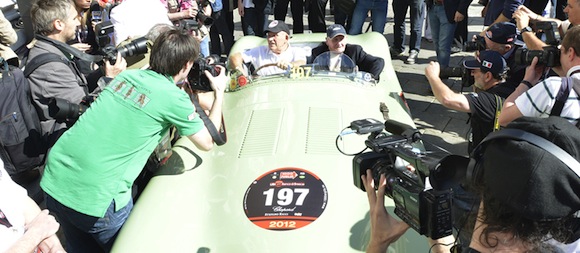Moss and Dewis recreate Jaguar history by starting the 2012 Mille Miglia!
Brescia, 17th May 2012.

60 years after they tackled the 1952 Mille Miglia in a C-type Jaguar equipped with a prototype disc-brake system, Sir Stirling Moss and his co-driver, Norman Dewis, today recreated history by taking the start of the 2012 event, now the world's most prestigious regularity rally.
Once again, the pair were behind the wheel of a Jaguar C-type, this car being chassis XKC 005 - the very car which, later in 1952, Sir Stirling Moss drove to victory in a sports car race in Reims thereby recording the first ever competition win for a disc braked car.
Just as they did in 1952, Moss and Dewis started this year's Mille Miglia from beside rather than on the start ramp - as 60 years ago Moss was concerned about the danger of grounding out the C-type - before completing a parade lap around Brescia behind a police escort.
The participation of Sir Stirling Moss and Norman Dewis - then Jaguar's chief development engineer - in the 1952 Mille Miglia represented the first competitive endurance test for the prototype disc-brake system. The C-type certainly caused a stir at scrutineering that year as officials had to be convinced that the disc-brakes were, in fact, brakes at all, and though the pair were forced to retire the car with steering damage, the escapade proved the worth of disc brakes. Following Sir Stirling Moss' later win at Reims, in 1953 disc-braked C-types finished first, second and fourth at Le Mans marking another vital step in the development of the technology by Jaguar for wide-scale automotive use.
Remembering the 1952 Mille Miglia Sir Stirling Moss said: "The disc brakes were incredible. Whereas the Ferrari and Mercedes could all brake once pretty well and then overheat, the Jaguar could repeatedly stop later and faster over and over again, and the Mille Miglia was the ultimate real world test. It was a joint idea between the team - where could we go, on the road, at racing speeds over a thousand miles - and we said if it can do this, then we will have a production brake that we can make available."
Norman Dewis also remembers the questions over the brakes well: "We got called into the scrutineers, and they're looking around the car until they call us over and of course with the wire wheel you can clearly see behind the wheel, and the man says 'Where is the brake? This car has no brakes!' And I had to say 'No, this is a new brake', and we had to show them that they worked by jacking the car up and taking the wheel off to demonstrate. They were so interested."
Following the parade lap by Moss and Dewis, the C-type XKC 005 joined the other five Jaguar Heritage Racing entries in this year's Mille Miglia to take the start of the event with its official crew. The additional five Jaguar Heritage Racing entries include two more C-types (XKC 018, first owned by Juan Manual Fangio, and XKC 045), a Mk VII saloon, and both roadster and fixed-head examples of the XK 120.
Following the six Jaguar Heritage Racing entries on the 2012 Mille Miglia will be support teams in the latest examples of the Jaguar range: XF, XJ and XKR-S - each of them models that have resulted from the same ethos of engineering and design innovation that was epitomised by the efforts of Moss and Dewis 60 years ago.
The 2012 Mille Miglia is the first competitive team outing for the Jaguar Heritage Racing programme which, later this year, will also see works-backed C- and D-types race competitively for the first time since 1956 at both the Nürburgring Oldtimer Grand Prix and the Goodwood Revival.
The 2012 Mille Miglia Jaguar Heritage Racing works-entry comprises:
- C-type (chassis: XKC 005, registration: MDU 212)
- C-type (chassis: XKC 018, registration: 70 XVK)
- C-type (chassis: XKC 045, registration: NDU 289 )
- Mk VII (registration: LHP 5)
- XK 120 OTS (registration: OOF 748)
- XK 120 fixed-head (registration: LWK 707)
Comments
No posts found

